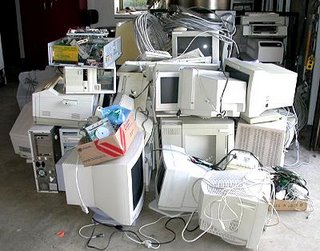
Study Tallies Environmental Cost of Computer Boom
FromUpdate
2004
Government incentives are quickly needed worldwide to extend the life of personal computers and slow the growth of high-tech trash, according to a new UN University (UNU) report into the environmental consequences of the information technology revolution.
The average 24 kg desktop computer with monitor requires at least 10 times its weight in fossil fuels and chemicals to manufacture, much more materials intensive than an automobile or refrigerator, which only require 1-2 times their weight in fossil fuels. Researchers found that manufacturing one desktop computer and 17-inch CRT monitor uses at least 240 kg of fossil fuels, 22 kg of chemicals and 1,500 kg of water – a total of 1.8 tonnes of materials.
While computers become smaller and more powerful, their environmental impacts are increasing. The materials- and energy-intense production process, greater adoption of PCs worldwide, plus the rapid rate at which they are discarded for newer machines, add up to growing mountains of garbage and increasingly serious contributions to resource depletion, environmental pollution and climate change.
"Today it is hard to imagine life without one of these indispensable 21st century tools," said Eric Williams, the UNU scientist who leads the Information Society and Environment Issues project and Ruediger Kuehr, who co-edited the book . "But it is exactly because they have become so ubiquitous that we must be aware of the negative impacts of the PC boom."
Sales of personal computers have exploded. The 300,000 "desktop" computer sales in the U.S. in 1980 increased 500% the following year and doubled again a year later. Today, despite the high-tech meltdown of the late 1990s, computer sales grow about 10 percent a year and more than 130 million computers are being sold each year around the world. By the end of 2002, one billion PCs had been sold worldwide.
The study examines a variety of environmental impacts associated with computer production processes. The main impacts are believed to be:
Significant energy use in the production and operation of computers.
Possible long-term health effects on workers, families and neighboring communities due to chemical exposure and emissions from production stages such as microchip fabrication.
Possible health impacts due to exposure to hazardous materials contained in computer products, in particular brominated flame retardants and lead. The main risk of exposure is probably from computers that have been dumped in landfills or from environmentally unsafe recycling processes in the developing world.
The high-tech nature of computer manufacturing makes it extremely energy intensive and therefore significant for climate change and depletion of fossil fuel resources.
Although computers use relatively less energy when they are in operation, the combination of a high-energy manufacturing process and a short lifespan raise its lifetime environment-related energy impacts to about the same level as a refrigerator, which is one of the more energy-intensive appliances in the home.
Monitors, and to a lesser extent computers, contain significant quantities of heavy metals such as lead, mercury, cadmium and chromium, which pose potential health risks to production workers and environmental risks to water supplies near landfills where they are eventually dumped.
"This study clearly shows that our current understanding of the health and environmental impacts of computers is inadequate," said UN Under Secretary-General and UNU Rector Hans van Ginkel. "We can no longer ignore the potential for serious long-term problems."
Among those involved in the UNU study, there is broad agreement that measures to extend the useful life of existing equipment are the most important pieces of a proposed framework for the environmental management of computers in the future.
Because so much of the energy used over the life cycle of a computer is in manufacturing high-tech components, which are usually destroyed in recycling processes to recover raw materials, the energy savings potential of reselling or upgrading is some 5-20 times greater than recycling, says Williams.
"Every computer user has a role to play. Users should think carefully about whether they really need to buy a new computer; if upgrading the existing machine could serve the same purpose. Promptly selling old machines to the used-product market is also important," he says.
UNU identifies several options available to national, regional and local governments intent on mitigating the environmental and health impacts of computers.
These include: the environmental regulation of manufacturing processes (e.g. setting standards for emissions from semiconductor factories) and the environmental characteristics of computer products (e.g. banning the use of lead and other heavy metals); mandatory product take-back, recycling systems and voluntary programs like eco-labeling; and funding research and analysis, as well as education and public awareness campaigns, on the environmental impacts of computers.
0 Comments:
Post a Comment
<< Home